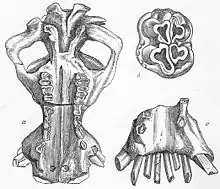Hexaprotodon
Hexaprotodon is a genus of Hippopotamidae that is sometimes applied to the pygmy hippopotamus. Pygmy hippos may be classified as either Choeropsis liberiensis or Hexaprotodon liberiensis. The name Hexaprotodon means "six front teeth" as some of the fossil forms have three pairs of incisors.[1][2] The genus sensu lato, including African taxa, has been suggested to be paraphyletic with respect to both species of living hippopotamus.[1] The uncontroversial, core Asian members of the genus most closely related to the type H. sivalensis were widespread throughout the Late Neogene and Quaternary of South and Southeast Asia, with the oldest records coming from the Late Miocene Siwaliks. They were extinct by the Late Middle Pleistocene in Southeast Asia, but survived in India until the terminal Pleistocene, with the latest dates being around 16,467–15,660 cal BP.[3]
| Hexaprotodon | |
|---|---|
 | |
| Hexaprotodon sivalensis skull elements | |
| Scientific classification | |
| Kingdom: | Animalia |
| Phylum: | Chordata |
| Class: | Mammalia |
| Order: | Artiodactyla |
| Family: | Hippopotamidae |
| Subfamily: | Hippopotaminae |
| Genus: | Hexaprotodon Falconer & Cautley, 1836 |
| Type species | |
| †Hexaprotodon sivalensis | |
| Species | |
|
Hexaprotodon liberiensis (disputed) | |
Species
The genus Hexaprotodon also includes a number of rarely studied extinct species from Asia.
- Hexaprotodon bruneti (Boisserie and White, 2004)
- Hexaprotodon crusafonti (Aguirre, 1963)
- Hexaprotodon hipponensis (Gaudry, 1867)
- Hexaprotodon imagunculus (Hopwood, 1926)
- Hexaprotodon iravticus (Falconer and Cautley, 1847)
- Hexaprotodon karumensis (Coryndon, 1977)
- Hexaprotodon liberiensis, pygmy hippopotamus?
- Hexaprotodon mingoz (Boisserie et al., 2003)
- Hexaprotodon namadicus (Falconer and Cautley, 1847 - possibly same as H. palaeindicus)
- Hexaprotodon palaeindicus (Falconer and Cautley, 1847)
- Hexaprotodon pantanellii (Joleaud, 1920)
- Hexaprotodon primaevus (Crusafont et al., 1964)
- Hexaprotodon protamphibius (Arambourg, 1944)
- Hexaprotodon siculus (Hooijer, 1946)
- Hexaprotodon sinhaleyus (Deraniyagala)
- Hexaprotodon sivajavanicus (Hooijer, 1950)
- Hexaprotodon sivalensis (Falconer and Cautley, 1836)
- Hexaprotodon sp. - Myanmar hippopotamus (fossil)

References
- Boisserie, Jean-Renaud (2005). "The phylogeny and taxonomy of Hippopotamidae (Mammalia: Artiodactyla): a review based on morphology and cladistic analysis". Zoological Journal of the Linnean Society. 143: 1–26. doi:10.1111/j.1096-3642.2004.00138.x.
- Hexaprotodon, The Paleobiology Database, läst 19 mars 2013.
- Jukar, Advait M.; Patnaik, Rajeev; Chauhan, Parth R.; Li, Hong-Chun; Lin, Jih-Pai (September 2019). "The youngest occurrence of Hexaprotodon Falconer and Cautley, 1836 (Hippopotamidae, Mammalia) from South Asia with a discussion on its extinction". Quaternary International. 528: 130–137. Bibcode:2019QuInt.528..130J. doi:10.1016/j.quaint.2019.01.005.